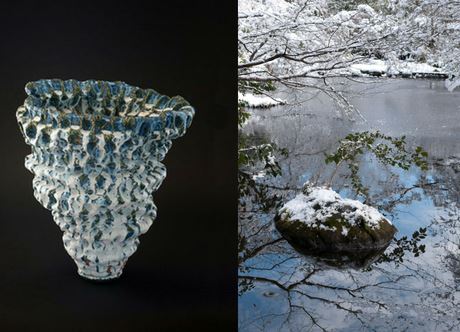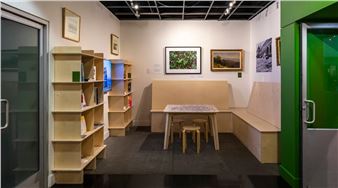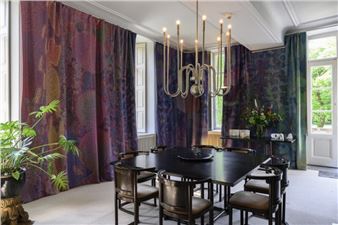Nature, Tradition and Innovation: Contemporary Japanese Ceramics from the Gordon Brodfuehrer Collection
The South Dakota Art Museum announced Nature, Tradition, and Innovation: Contemporary Japanese Ceramics from the Gordon Brodfuehrer Collection, an engaging interdisciplinary look at contemporary Japanese ceramics paired with nature photographs.
Christine Knoke of the Mingei International Museum is the exhibitвҖҷs curator. International Arts & Artists of Washington, D.C. organized the exhibit for tour. Jodi Lundgren, South Dakota Art Museum curator of exhibitions, sees this exhibit as an opportunity to display a rich variety of ceramics styles and techniques for museum visitors and students.
вҖңJapanese ceramicists are so clearly inspired by nature,вҖқ Lundgren said, вҖңand the works in this exhibition are exquisite. The Japanese mingei (folk art) tradition of ceramics was a major influence on American ceramicists in the studio pottery tradition. We look forward to the South Dakota State University students and other fine arts programs exploring and drawing inspiration from these works. We also know that visitors with or without a deep ceramics background will experience those вҖҳwowвҖҷ moments that we always hope to achieve with our exhibitions.вҖқ
Featuring 43 exceptional Japanese ceramists, this exhibition showcases ceramic objects of exceptional beauty made for everyday use. The 55 ceramic works chosen are closely associated with JapanвҖҷs historical pottery centers, and reinterpret traditional methods in a modern context. The almost spiritual link between ceramic making and nature is poetically highlighted by 11 digital photographs taken by photographer Taijiro Ito.
The exhibition provides a dynamic survey of the diverse and innovative practices of ceramic-making in JapanвҖ”from exquisite flower vases and serene tea bowls to robust plattersвҖ”revealing the earthly beauty of Japanese ceramics. This admiration for rugged-looking stonewares derives in part from the aesthetic of wabiвҖ”a cultivated simplicity and rusticityвҖ”which has been highly valued from the 15th century onward. It also derives from the Japanese deep-rooted love of nature and reverence of the kamiвҖ”higher beings, or spirits, that inhabit it.

Recommended for you
The South Dakota Art Museum announced Nature, Tradition, and Innovation: Contemporary Japanese Ceramics from the Gordon Brodfuehrer Collection, an engaging interdisciplinary look at contemporary Japanese ceramics paired with nature photographs.
Christine Knoke of the Mingei International Museum is the exhibitвҖҷs curator. International Arts & Artists of Washington, D.C. organized the exhibit for tour. Jodi Lundgren, South Dakota Art Museum curator of exhibitions, sees this exhibit as an opportunity to display a rich variety of ceramics styles and techniques for museum visitors and students.
вҖңJapanese ceramicists are so clearly inspired by nature,вҖқ Lundgren said, вҖңand the works in this exhibition are exquisite. The Japanese mingei (folk art) tradition of ceramics was a major influence on American ceramicists in the studio pottery tradition. We look forward to the South Dakota State University students and other fine arts programs exploring and drawing inspiration from these works. We also know that visitors with or without a deep ceramics background will experience those вҖҳwowвҖҷ moments that we always hope to achieve with our exhibitions.вҖқ
Featuring 43 exceptional Japanese ceramists, this exhibition showcases ceramic objects of exceptional beauty made for everyday use. The 55 ceramic works chosen are closely associated with JapanвҖҷs historical pottery centers, and reinterpret traditional methods in a modern context. The almost spiritual link between ceramic making and nature is poetically highlighted by 11 digital photographs taken by photographer Taijiro Ito.
The exhibition provides a dynamic survey of the diverse and innovative practices of ceramic-making in JapanвҖ”from exquisite flower vases and serene tea bowls to robust plattersвҖ”revealing the earthly beauty of Japanese ceramics. This admiration for rugged-looking stonewares derives in part from the aesthetic of wabiвҖ”a cultivated simplicity and rusticityвҖ”which has been highly valued from the 15th century onward. It also derives from the Japanese deep-rooted love of nature and reverence of the kamiвҖ”higher beings, or spirits, that inhabit it.

 ARTISTS
ARTISTS













